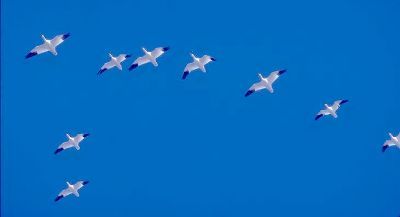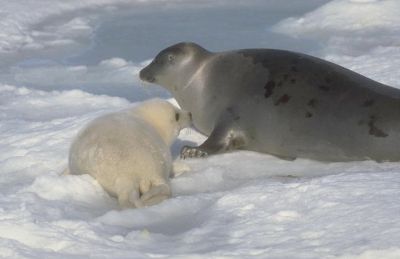by Larry
September, 2004Uneven Changes Leave Many Species StrandedOne reason a number of biologists think the current die-off of species will be so severe, comparable to five previous periods of mass extinctions that marked the ends and beginnings of major ages in the development of life on earth, is that with global warming there are uncoordinated shifts in the habits of interdependent species. It is as if millions of travelers, who need to make several transfers on airline trips to the other side of the world, find that, perhaps due to computer viruses, their tickets and flights have been subtly and randomly altered in relation to other transport or the landing sites, so that each time they arrive, it is now perhaps at a small airport, where few other planes ever land, or it turns out to be a few minutes, hours, or days after all connecting aircraft have already departed, or the landing site, where our travelers had counted on periods of rest (or even a little reproductive activity) before continuing their journeys, turns out to have all services indefinitely shut down due to strikes or bad weather, or the airport surfaces, which had always been hard and frozen for safe wheeled aircraft landings before, are now melted and turned to slush or water, or else they discover, no doubt in horror, that terrorists have taken over, their lives are in great peril, and there are no adequate means of defense, with nowhere to hide. In the natural world, (the biological equivalent of the social predicament: "What if you threw a party and nobody came?"), as spring-like conditions are arriving earlier, species that depend on each other or on a now rapidly changing environment are adjusting as best they can but in different ways or at divergent rates, and often are arriving after the optimum time, or when new conditions have made their species' continued existences much more tenuous.
The food chain may be cut, for instance, if caterpillars have already gone into the pupa stage by the time the birds show up that used to eat them. Often just a few days' difference can be critical, and if the larvae are unchecked by most of their natural predators, they will tend to decimate the plants on which they feed, or to mature and lay eggs in larger numbers, leading to a greater plague later. Alternatively, if early birds arrive well before their insect "worms" hatch out, they could be going hungry just when they need to be feeding new nestlings. While a great deal of such seasonal variations are already built into our ecosystems without tragic consequences, the scale of the discontinuity or out-of-sync developments now, and anticipated for the relatively near future, goes far beyond anything normally occurring, threatening to pull apart nature's fabric of interdependence, destroying whole systems and creating new ones as never before in historic times. The speed and magnitude of the transformation are reminiscent of what occurred at the end of the last ice age. Many species, inevitably, simply won't have a place in the rapidly evolving new biological order. In some situations the disconnect is between the habitat itself and the species that have depended on it. The healthy temperature range for an animal or plant may now be exceeded in its traditional area. Those species with the capacity and opportunity to do so will move to new areas where their optimum temperature ranges now prevail. But what of those, such as trees, that lack easy mobility or which find impossible natural barriers, perhaps seas or deserts, in their way? They are out of luck.
This sort of thing is no longer just theoretical. To offer one illustration, the disappearance of spring ice in Canada's Gulf of St. Lawrence has hurt the harp seal population. Potentially hundreds of thousands of seal pups have drowned as their mothers gave birth in the open water, unable to find Gulf ice on which to bear their young.
The synchrony of plant, animal, and seasonal habitat cycles depends on sensitivity to triggers that are often not currently reliable. For migratory fowl, the pace of change in the wintering areas often is not the same as in their summer sites. In general, the closer to the Equator, the less pronounced the global warming effects. Thus if the birds follow the usual, relatively unchanged, cues around them in their wintering grounds, for when to fly to the more temperate or arctic summer regions, they will tend to arrive after the ideal breeding and feeding times, at the expense of their chicks. The most dramatic global warming changes so far have been for winter temperatures on the Antarctic Peninsula, now nearly 11°F (6°C) higher than 50 years ago. Thanks to a prevalence of sea ice in the area, the rising mercury has resulted in increasing snowfalls and snow melts at times when heretofore the ground would have been bare and dry. The yearly melt season there has increased by about three weeks in only the last two decades. The new circumstances are decimating the Fraser's Adélie penguin population, which needs bare, dry ground for its pebble nests. Scientists think the deviations there are a precursor to more widespread perturbations to come in the overall planet's delicate web of life, as global warming continues to affect more areas with increasing, yet unsynchronized modifications.
Research into the destruction of then existing natural patterns and the creation of new ones at the end of the last ice age suggests that our not so distant future includes a set of previously unknown and perhaps radically new ecosystems which will have far fewer (with some quite different) species than those with which we have been familiar for the last several thousand years.
Spring Forward. Daniel Grossman in Scientific American, Vol. 290, No. 1, pp. 84-91; January, 2004. Global Warming - Early Warning Signs in Climate Hot Map; 1999. An Early Melting Hurts Seals, Hunters in Canada. Colin Nickerson in The Boston Globe; April 1, 2002. |
 As a result, many of the sustaining connections between species or between them and their habitats are being severed. Plants bloom later or sooner, for example, than the insects arrive on which they depend for pollination. Predators arrive too late to take advantage of the greatest numbers of their prey. Birds lay their eggs when the environment is not suitable for nesting. Mammals find their environments so altered they can no longer complete their life cycles successfully.
As a result, many of the sustaining connections between species or between them and their habitats are being severed. Plants bloom later or sooner, for example, than the insects arrive on which they depend for pollination. Predators arrive too late to take advantage of the greatest numbers of their prey. Birds lay their eggs when the environment is not suitable for nesting. Mammals find their environments so altered they can no longer complete their life cycles successfully.
